The Plenary of IFT resolved that the contractual relations between Telmex and Dish México constitute a concentration that should be notified prior its performance (Press Release 02/2015)
The Plenary of IFT resolved that the contractual relations between Telmex and Dish México constitute a concentration that should be notified prior its performance
• A fine was imposed for failure to report acts in which Telmex acquired control over Dish México
• This constitutes a not notified concentration in accordance to the Federal of Economic Competition Law
• Imputes liability to a company of Dish México economic group for submitting false information in the procedure
• The Institute conducted an analysis of the effects of this transaction and determined that they were not against the Federal Economic Competition Law (Ley Federal de Competencia Económica, LFCE)
• The penalty was not imposed as a result of a harmful practice for the market but for the breach of the obligation to notify a concentration before testing
On October 4th, 2013, the Federal Telecommunications Institute (Instituto Federal de Telecomunicaciones, IFT) received from the now extinct Federal Competition Commission (Comisión Federal de Competencia, CFC) the record of an investigation into the possible realization of prohibited conduct by Federal Economic Competition Law (Ley Federal de Competencia Económica, LFCE) in markets of provision of restricted television and audio service, wireline and service access to broadband Internet.
The investigation resulted for the accumulation of three complaints against Telmex, Dish México and companies belonging to their respective economic groups by the probable realization of various events which could constitute violations to the LFCE. The research is not limited to the complaints content, it aims to verify whether the operators act in compliance with the LFCE.
On February 24th, 2014 the research phase conclude. Later, during the month of May that year, the Unit for Monitoring and Verification of IFT sent the UCE various documents by Telmex and COFRESA —a company of the economic group of Dish México— that, by referring to coincide with the analyzed events, was considered by the Head of the UCE for the issuance of the Office of Probable Responsibility (Oficio de Probable Responsabilidad, OPR) of May 20th, 2014.
The OPR charged probable responsibility to Telmex, Dish México, and their respective economic groups companies for the performance of a concentration without having previously notified the authority, as mandated by the LFCE. That complaint was based on facts that had already made taken effect since 2008. Once notified of OPR, all interested operators in the procedure had the opportunity to present evidence and arguments before the IFT.
During the months of May to November the presentation of evidence and arguments were vented. Furthermore, in November 24th, 2014, in response to requests submitted by the parties, the IFT Plenary granted a hearing to the economic agents with legal interest in the proceedings, effect submit their statements directly to the Commissioners of the IFT, which took place on December 3rd of that year.
After evaluating the OPR, testing and demonstrations of the parties to the proceedings, on January 7th, 2015, the IFT Plenary resolved that:
• Telmex, through its subsidiary Teninver, acquired control of the company Dish México, through various contracts, which constitute a concentration in terms of the LFCE.
• For the amount of these acts, the concentration was subject to the obligation to be notified before its implementation. The parties failed to comply with this legal obligation, so they were sanctioned in the terms established by the LFCE.
• Cofresa, a company belonging to the same group of Dish México economic interest, was held responsible for having falsely declared to the authority for this procedure.
Based on this and on the basis of Article 35, section VII, of the LFCE, the IFT Plenary resolved to impose the following penalties:
1) To Teléfonos de Mexico, S.A.B. de C.V. a fine in the amount of $ 10,518,000.00 (ten million five hundred and eighteen thousand pesos 00/100 M.N.).
2) To Teninver, S.A. de C.V. a fine in the amount of $ 3,895,600.00 (three million eight hundred ninety-five thousand six hundred pesos 00/100 M.N.).
3) To Comercializadora de Frecuencias Satelitales, S. de RL de C.V. a fine in the amount of $ 3,098,249.30 (three million ninety-eight thousand two hundred forty-nine pesos M.N 30/100).
4) To Corporativo Mexicano de Frecuencias Dish, S.A. de C.V. $ 8,553,789.20 (eight million five hundred fifty-three thousand seven hundred eighty-nine pesos 20/100 M.N.).
5) To Dish México Holdings, S. de R.L. de C.V. a fine in the amount of $ 10,518,000.00 (ten million five hundred and eighteen thousand pesos 00/100 M.N.).
6) To Dish Mexico, S. de RL de C.V. a fine in the amount of $ 10,518,000.00 (ten million five hundred and eighteen thousand pesos 00/100 M.N.).
7) To Grupo Frecuencia Modulada Televisión, S.A. de C.V. a fine in the amount of $ 10,518,000.00 (ten million five hundred and eighteen thousand pesos 00/100)
8) To Echostar México Holdings Corporation a fine in the amount of $ 10'518,000.00 (ten million five hundred and eighteen thousand pesos 00/100 M.N.).
While the parties were penalized for not perform the notice to which they were bound, the Institute conducted an analysis of the effects of this transaction and determined that they were not contrary to the LFCE.
The penalty was not imposed as a result of harmful practice for the market, but by the failure to notify a concentration, which obstructed the possibility for the authority to exercise its preventive powers that both the Constitution as the LFCE give to the IFT in economic competition.
Thus, the resolution of January 7th, 2015 concludes a procedure carried out in terms of the LFCE, which does not prejudge the effects of these events have under the Federal Telecommunications and Broadcasting Law or other applicable provisions.
The decision was notified to the sanctioned economic agents who had knowledge of this on 8th and 9th January 2015, in accordance with the provisions of the LFCE. Therefore, in attachment to the legal provisions applicable to these procedures, the Institute informs the public of this resolution until today, once the notices to sanctioned operators have produced legal effects.
IFT Plenary resolved interconnection disputes (Press Release 18/2015)
IFT Plenary resolved interconnection disputes
• Correspond to companies Alestra and Pegaso PCS, and NII Digital both GTM as Total Play Telecomunicaciones
• The Plenary of the Institute determined the rates payable by companies in the period between 2012 and 2015
• The resolutions that refer to switched termination services for users of mobile and fixed networks, mainly
The Plenary of the Federal Telecommunications Institute (Instituto Federal de Telecomunicaciones, IFT) resolved in ordinary session, the interconnection disputes between the companies Alestra, S. de R.L. de C.V. and Pegaso PCS, S.A. de C.V. and Digital NII, S. de R. L. de C.V. with Grupo de Telecomunicaciones Mexicanas, S.A. de C.V. and with Total Play Telecomunicaciones, S.A. de C.V. respectively.
Cases of Alestra with Pegasus; and the Digital NII with GTM for the years 2012, 2013 and 2014, they began their process prior to the entry into force of the Federal Telecommunications and Broadcasting Law (Ley Federal de Telecomunicaciones y Radiodifusión, LFTR), while the process of NII Digital with Total Play for the corresponding rates for the financial year 2015 began its proceedings during the term of this.
Thus the IFT ruled:
Alestra-Pegaso PCS:
• The interconnection fees payable to Alestra Pegaso PCS for switched termination services on mobile users under the arrangements "calling party pays" and "national calling party pays" will be as follows:
a) From January 1° to December 31, 2012, $ 0.3214 pesos M.N. per interconnection minute.
b) From January 1° to December 31, 2013, $ 0.3144 pesos M.N. per interconnection minute.
c) From January 1° to August 12, 2014, $ 0.3199 pesos M.N. per interconnection minute.
For the period from August 13 to December 31, 2014, shall be extended the interconnection rate indicated for the period from January 1 to August 12, 2014.
NII Digital and GTM:
2012, 2013 and 2014
• The interconnection rate that NII Digital and GTM must pay each other for switched termination services on fixed users in the Local Service Area with interconnection point will be:
a) From January 1° to December 31, 2012, $ 0.02432 pesos MN per interconnection minute.
b) From January 1° to 31 December 31, 2013, $ 0.02392 pesos MN per interconnection minute.
c) From January 1° to August 12, 2014, $ 0.02445 pesos MN per interconnection minute.
2015
• The interconnection rate that NII Digital and GTM most pay each other for termination services on local service for fixed users, from March 13 to December 31, 2015, will be $ 0.004179 pesos M.N. per interconnection minute.
• For the period from January 1° to March 12, 2015, the rate for fixed local service users will be determined by the Institute for 2014.
NII Digital-Total Play:
2014
• The interconnection rate NII Total Play Digital and must pay each other for switched termination services for fixed users from January 1° to August 12, 2014 will be $ 0.02445 pesos M.N. per interconnection minute, this shall be extended for the period from August 13 to December 31, 2014.
• The interconnection fee that Play Total must pay to NII Digital, from January 1° to August 12, 2014, for switched termination services for mobile users under the modality "calling party pays" and "national calling party pays ", will be $ 0.3199 pesos M.N. per interconnection minute, same shall be extended for the period from August 13 to December 31, 2014.
2015
• The interconnection rate that Total Play must pay to NII Digital for switched terminating services for mobile users under the modality "calling party pays" and "national calling party pays" from March 13 to December 31, 2015 will be $ 0.2505 pesos M.N. per interconnection minute.
• The interconnection rate that NII Digital and Total Play must pay each other for termination services on fixed local service users, from March 13 to December 31, 2015, will be $ 0.004179 pesos M.N. per interconnection minute.
• For the period from January 1°, 2015 to March 12, 2015, both for termination service of local service in mobile users under the modality "calling party pays" to the termination service of local service of fixed users, the above rates will be extended.
• No place to determine the rate applicable to transit service whenever Total Play is not obligated to provide those services, in terms of the Federal Telecommunications and Broadcasting Law (Ley Federal de Telecomunicaciones y Radiodifusión, LFTR).
In all cases, the consideration payable by the parties shall be calculated based on the actual duration of calls, unrounded minute.
Documentos para descargar
Temas relacionados
Pleno del IFT resuelve someter a consulta pública el Anteproyecto de Lineamientos generales para otorgar concesiones de telecomunicaciones y radiodifusión (Comunicado 25/2015)
Pleno del IFT resuelve someter a consulta pública el Anteproyecto de Lineamientos generales para otorgar concesiones de telecomunicaciones y radiodifusión
- También se realizará una consulta a pueblos indígenas sobre los Lineamientos para el otorgamiento de concesiones, mediante tres talleres regionales informativos y tres talleres regionales consultivos
- Se traducirá a 10 lenguas indígenas un extracto con los puntos más importantes
- Resolvió las condiciones de interconexión no convenidas por servicios de originación, terminación y tránsito entre Alestra y las empresas Telmex y Telnor
En sesión extraordinaria celebrada el día de ayer, el Pleno del Instituto Federal de Telecomunicaciones (IFT), resolvió someter a consulta pública el Anteproyecto de Lineamientos generales para el otorgamiento de la concesión única y la concesión sobre espectro radioeléctrico y recursos orbitales, así como también realizar una consulta a pueblos indígenas sobre los Lineamientos para el otorgamiento de concesiones.
La consulta pública estará disponible durante un periodo de 20 días hábiles contados a partir del día hábil siguiente al de su publicación en el portal de Internet del Instituto.
En tanto, la consulta a pueblos indígenas se realizará mediante tres talleres regionales informativos y tres talleres regionales consultivos. Los comentarios y aportaciones recibidas serán analizados y valorados por un Comité Técnico integrado por el Instituto, la Comisión Nacional para el Desarrollo de los Pueblos Indígenas (CDI) y el Instituto Nacional de Lenguas Indígenas (INALI). Para tal efecto, habrá un extracto del Anteproyecto traducido a 10 lenguas indígenas.
La difusión de los resultados de dicha consulta se hará a través de un documento que brinde respuestas generales a las participaciones, opiniones y comentarios, el cual se publicará en la página de Internet del IFT, se hará del conocimiento de los pueblos consultados y se enviará a la CDI con objeto de que se difunda a través de sus diferentes medios (delegaciones, centros coordinadores, Sistema de Radiodifusoras Culturales Indigenistas, entre otros).
De igual forma, una vez que se emitan los lineamientos, se elaborará un manual que tenga por objeto describir de manera sencilla y práctica el procedimiento para la obtención de concesiones de uso social indígena.
Por otra parte, el Pleno del IFT en sesión extraordinaria celebrada el día 7 de abril pasado, resolvió las condiciones de interconexión no convenidas por servicios de originación, terminación y tránsito entre Alestra, S. de R.L. de C.V. y las empresas Teléfonos de México S.A.B de C.V. y Teléfonos de Noroeste, S.A. de C.V., para el año 2013.
El Instituto determinó las siguientes tarifas de interconexión para las redes públicas de las tres empresas en el periodo comprendido del 1 de enero al 31 de diciembre del citado año:
Servicio de interconexión
| Tarifa de interconexión por minuto (en pesos, M.N.) | Tarifa de tránsito por minuto (en pesos, M.N.) |
Dentro del mismo nodo regional | $0.02392 | $0.00968
|
Entre nodos regionales que dependen de un nodo nacional | $0.02683 | $0.01259
|
Entre nodos regionales que dependen de diferentes nodos nacionales | $0.02780 | $0.01356
|
El cálculo de las contraprestaciones que Alestra deberá pagar a Telmex y Telnor se realizará con base en la duración real de las llamadas, sin redondear al minuto siguiente.
Documentos para descargar
Temas relacionados
Lower prices of telecommunication services by operation of regulatory measures and concessionaires new packages (Press Release 17/2015)
Lower prices of telecommunication services by operation of regulatory measures and concessionaires new packages
• While the National Consumer Price Index (CPI) registered a growth rate of 7.2% between February 2013 and January 2015, the communications price index fell by 15.3%
• In mobile telephony reduced prices were observed in 16.7% for that period
• In Long International Distance there was a decrease of 40% from January 2015, indicating an indirect impact by eliminating the charge for Long National Distance, because the operators included minutes for calls abroad in their plans
Under the behavior observed in the price indices reported by the National Institute of Statistics and Geography (Instituto Nacional de Estadística y Geografía, INEGI), the Federal Telecommunications Institute (Instituto Federal de Telecomunicaciones, IFT) conducted an analysis of the various price indices of services that integrate it, particularly those that make up the telecommunications sector.
The price index of communication has become increasingly important within the basic basket of consumer services. It currently has a weighting in the overall National Consumer Price Index (CPI) of 4%. This weighting is higher, e.g. the total of fruits and vegetables, beef, pork and chicken as a whole.
Figure 1 shows the behavior of the index during the period between February 2013 and January 2015. The growth rate of the CPI during the study period was 7.2%, while the communications price index for the same period decreased by 15.3 percent.
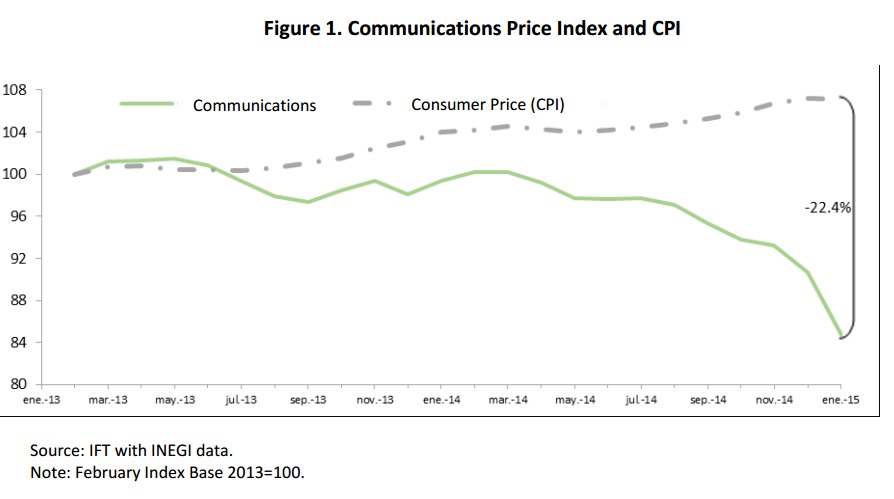
Price indices for telecommunications sector services
From the components of the overall price index communication behavior of prices, six services within the telecommunications sector were analyzed:
• Mobile Telephony
• Fixed Telephony
• National long distance
• International Long Distance
• Internet
• Restricted TV
In all cases a comparison of these indices compared to the CPI was carried out.
Mobile Telephony
From February 2013 to March 2014, the price index of mobile phone service has averaged 100.3 points, i.e., on average there were no significant changes during this period, since the base of the index equals 100. Later a fall in the index is observed, it is emphasized after the first quarter of 2014.
During the analyzed period the rate of change of the price index of mobile services decreased by 16.7%, which contrasts with the increase of 7.2% in the CPI (see Figure 2). Of the services analyzed, this is the one that presents more global communications price index (correlation about 97%) alike behavior.
In the case of mobile telephony during the period under review were two factors that presumably could have affected the change in the trend of the price index:
• The statement of the Preponderant Economic Agent (PEA) in March 2014, which resulted on the removal of roaming charge, unlock of equipment and imposition of charges to PEA for asymmetric interconnection since April.
The entry into force of the Federal Telecommunications and Broadcasting Law (Ley Federal de Telecomunicaciones y Radiodifusión, LFTR) in August 2014, where is established the zero rate at PEA interconnection.
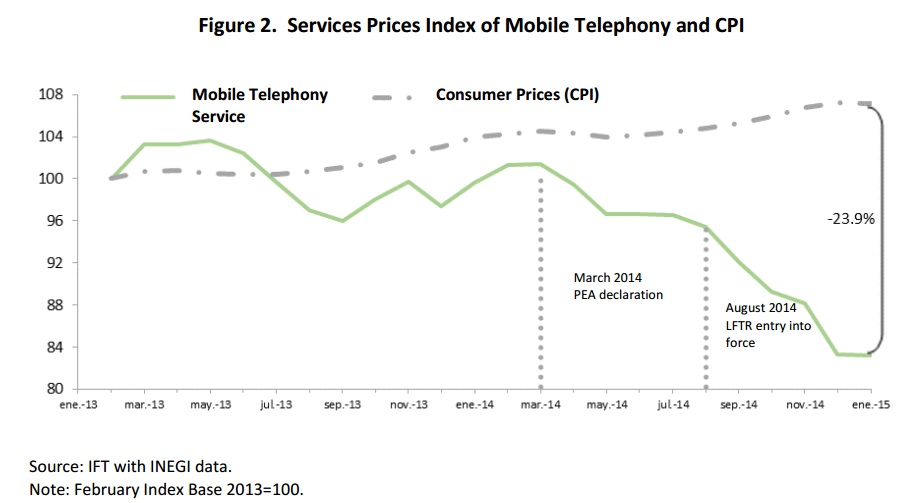
National Long Distance (NLD)
From January 2015, charges for national long distance were removed. This implied that all calls made by users in the country were considered local. The impact of this measure on the price index of NLD is that from the beginning of 2015 the index is zero (see Figure 3).
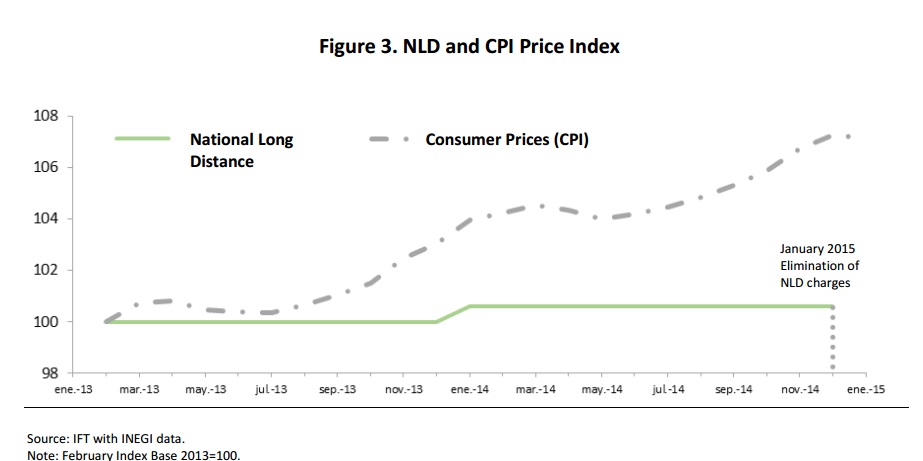
International Long Distance (ILD)
Regarding ILD price index, the elimination of charges for NLD had an indirect impact, but significant. This includes an improvement in offering fixed telephony packages offered by operators, including the PEA, in late 2014, whose purpose is to make their products more competitive. These included international minutes within their packages while the price of additional international minutes decreased. This translates into a 40% decline from January 2015.
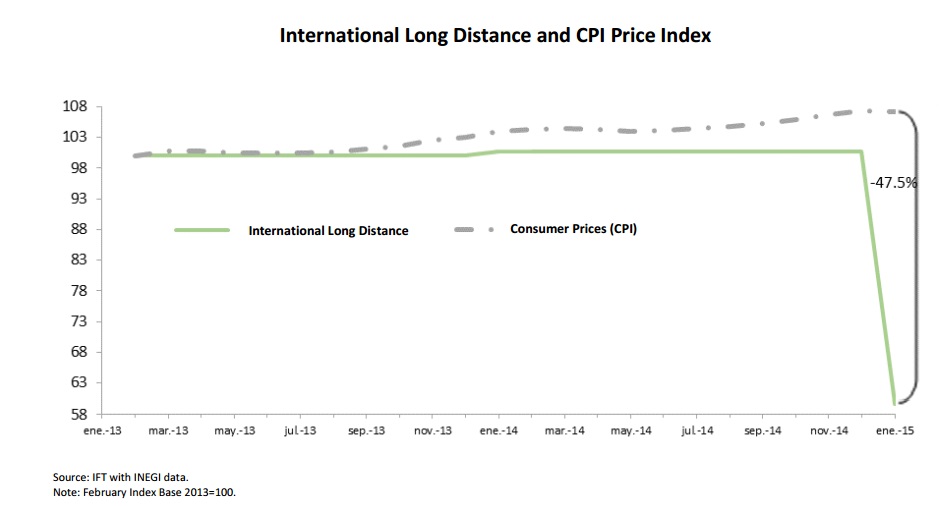
Fixed telephony
The price index of fixed local telephone service noted a decrease of 4.6% in the period analyzed, which can be also explained by the introduction of new packages of fixed telephone services at the end of 2014, as mentioned above.
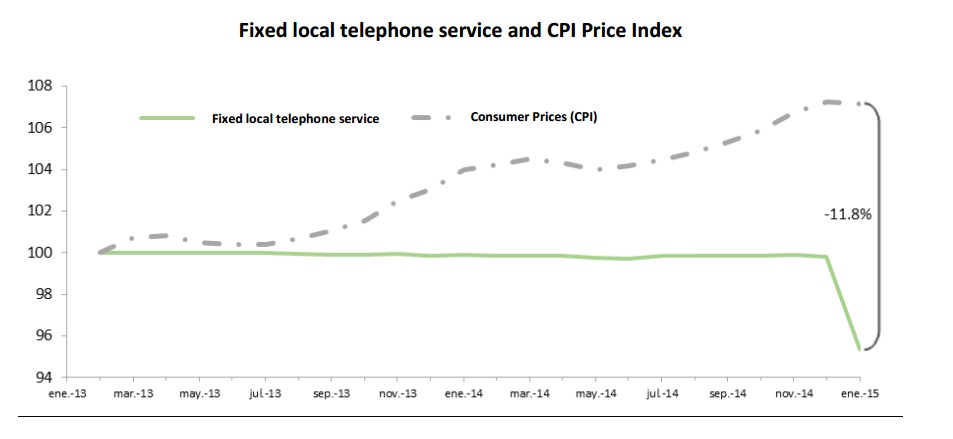
Restricted TV
The restricted television service index of prices showed a growth of only 2.5% during the study period. This growth is equivalent to just under a third of the recorded by the CPI during the same period. Note that this was the only sector of telecommunications service that recorded an increase.
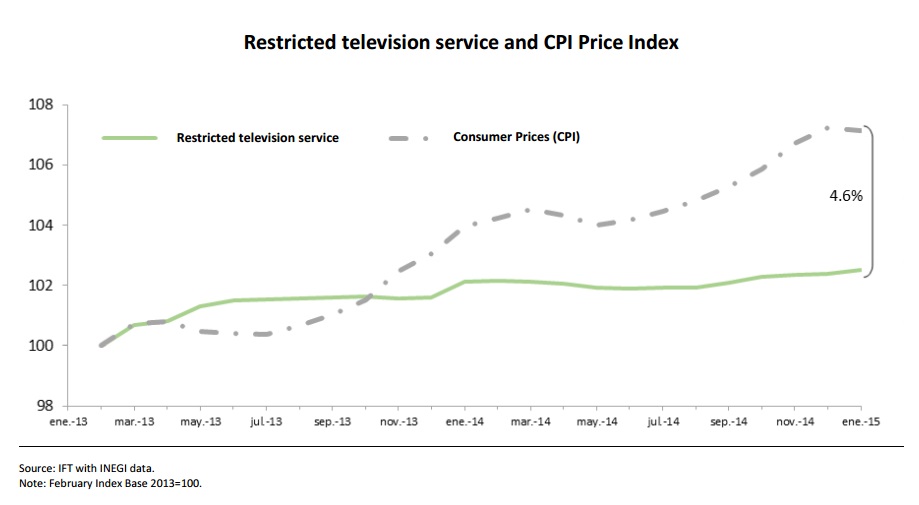
Internet
The price index of Internet service recorded a decrease during the period of 0.8%, but it is worth noting that when compared with growth of 7.2% in the CPI represent a significant decrease in real terms.
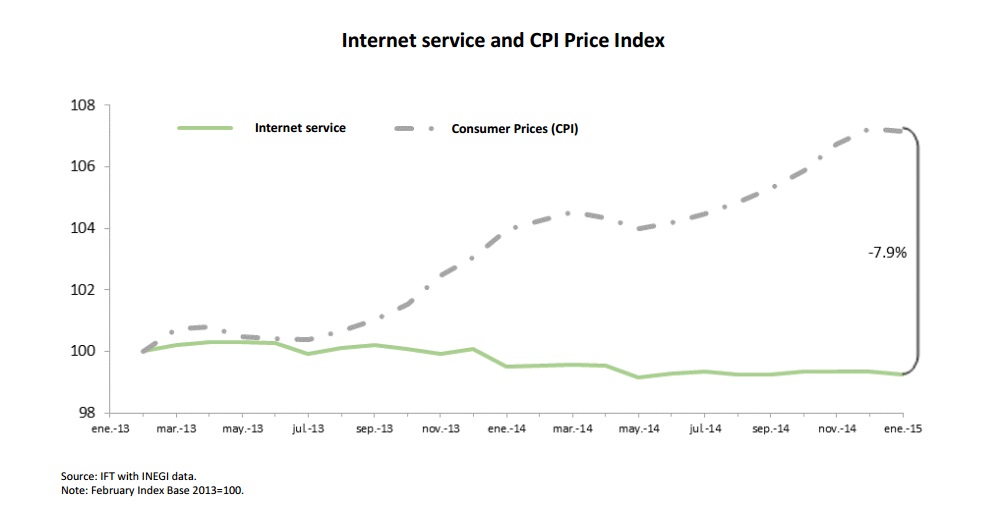
Structural change in the communications price index
A statistical exercise was conducted to the series of communications price index in order to find evidence of any structural change after the entry into force of the measures related to the declaration of preponderance on March 2014. Two periods were defined: November 2007 to March
2014 and April 2014 to January 2015.[1] Although the analysis does not prove causality between regulatory measures and the price index reduction, it does reveal statistical evidence that prices decline further in communications from regulatory measures mentioned above, which shows evidence of an structural[2] change.
Summary table
The following table presents a summary of the price indices presented. The difference with respect to CPI is calculated as the difference between the rate of change of the CPI and the exchange rate of the respective indices. It is observed that all growths, except the index of restricted television service, are negative for the CPI. This means that these indices behaved contrary to the CPI increase.
Price Index | Rate of change (%) Feb 13 - Jan 15 | Differential in respect to CPI |
Consumer Price Index (CPI) | 7.2 | NA* |
Communications Index | -15.3 | -22.4 |
Restricted television service | 2.5 | 4.6 |
Internet service | -0.8 | -7.9 |
Local fixed telephone service | -4.6 | -11.8 |
Mobile telephone service | -16.7 | -23.9 |
International long distance | -40.3 | -47.5 |
National Long Distance | -100.0 | -107.2 |
[1] These two periods were defined because from November 2007 began a downward trend in the communications price index. The average annual growth rate for the period November 2007 to March 2014 was -3.4%, while the average rate of annual growth in April 2014 to January 2015 was -18.9%.
[2] The statistical method to infer structural change Chow test was used. The results show that there is a structural change of structural change from April 2014 with a higher level of significance at 98%.
Documentos para descargar
Temas relacionados
IFT installs its Ethics and Inclusion Committee (Press Release 16/2015)
IFT installs its Ethics and Inclusion Committee
• The licensed body will promote a culture of integrity and practices of inclusion and nondiscrimination in the workplace
• The Committee is integrated for workers of the Institute freely and secretly elected
• Ricardo Bucio, president of CONAPRED, attends the meeting as a special guest
• Developments are presented in terms of inclusion and design of the new IFT portal with accessibility features
Today the Ethics and Inclusion Committee of the Federal Telecommunications Institute (Instituto Federal de Telecomunicaciones, IFT) was installed, its function will be to promote a culture of integrity and non-discrimination to allow a stimulating and participatory internal working environment, based on trust, dignity respect, diversity and equity, in order to contribute to the objectives and institutional goals.
The Ethics and Inclusion Committee of IFT was formed through the involvement of staff of the Institute, through a process of free and secret ballot. It is integrated by the Commissioner President of the Institute, Gabriel Contreras, Commissioner Adriana Labardini, representing the Plenary and workers of different hierarchical levels, in addition to the Head of the Unit of Administration, Mario A. Focil Ortega, who serves as Technical Secretary.
To the Installation session attended as a special guest, Ricardo Bucio Mújica, Chairman of the National Council to Prevent Discrimination (Consejo Nacional para Prevenir la Discriminación, CONAPRED), who offered to the attendees the "General Framework for the Prevention of Discrimination" conference, with the aim of providing the Committee members the biggest technical elements and knowledge on issues of inclusion, equality and non-discrimination.
As part of its first actions, the Ethics Committee noted the training activities to be undertaken to achieve an adequate knowledge and understanding of the Declaration of Principles and Code of Conduct approved by the Plenary of the Institute for all staff.
Similarly, the actions the IFT has been conducting on inclusion were highlighted:
1. Monica Duhem, specialist in accessibility for people with disabilities, held a demonstration of the new interactive portal of the Institute, which will include accessibility features that will help to achieve the "W3C AA" certification. To be put into operation soon.
2. Installation of the Institute Committee for the Prevention and Treatment of Cases of Violence, which allows for a close and direct request for expressing grievances and receive orientation[1] for cases of workplace bullying, harassment and sexual harassment. Its aim is that people who live these forms of violence, count on a mechanism that allows them the access to justice.
3. Implementation of the Program of Educational Backwardness Abatement in the IFT, conducted in collaboration with the National Institute for Adult Education (Instituto Nacional para la Educación de los Adultos, INEA).
4. Design of the IFT Professional Service System so their benefits can be generally applicable to all staff, as well as, where appropriate, the spouse, cohabitant, concubine and any figure recognized by the applicable law for same-sex couples .
5. Paternity licenses and staff support to cover childcare and / or preschool.
6. Facilities that allow accessibility for people with disabilities, including: access ramps, handrails, bathroom facilities on each floor of offices located in accessible places and marked, elevators with call button with embossed symbols and some with Braille, easy operation and door lever handles, parking spaces for persons with disabilities, and international symbol signs of accessibility for people with disabilities.
[1] Based on the "Intervention Protocol for harassment and sexual harassment" issued by the National Institute for Women (Instituto Nacional de las Mujeres, INMUJERES).
Documentos para descargar
Temas relacionados
Acuerdo de colaboración institucional del IFT y el INEGI para realizar la Encuesta Nacional sobre Disponibilidad y Uso de Tecnologías de la Información en los Hogares (ENDUTIH) 2015 (Comunicado 24/2015)
Acuerdo de colaboración institucional del IFT y el INEGI para realizar la Encuesta Nacional sobre Disponibilidad y Uso de Tecnologías de la Información en los Hogares (ENDUTIH) 2015
- La nueva ENDUTIH 2015 sustituirá a la MODUTIH que el INEGI realizaba anualmente desde el 2001 como un módulo de la Encuesta Nacional de Ocupación y Empleo (ENOE)
- Al convertirse en encuesta, la información se obtendrá a nivel de usuario y no solo a nivel de hogar, como por ejemplo los usos específicos de las Tecnologías de la Información (TIs) por grupo de edad y sexo
- Por vez primera, incorporará representatividad de los resultados en 32 ciudades con mayor actividad económica en el país
- Permitirá identificar con mayor claridad los usos que la población le da al Internet con una metodología establecida por la Unión Internacional de Telecomunicaciones (UIT)
El Instituto Federal de Telecomunicaciones (IFT) y el Instituto Nacional de Estadística y Geografía
(INEGI), firmaron un convenio, con el fin de colaborar en el levantamiento de información para la
Encuesta Nacional sobre Disponibilidad y Uso de Tecnologías de la Información en los Hogares
(ENDUTIH) 2015.
Como parte de dicho convenio, a partir de este año la ENDUTIH será una encuesta independiente y dejará de ser levantada como un Módulo sobre Disponibilidad y Uso de las Tecnologías de la Información en Hogares (MODUTIH) de la Encuesta Nacional de Ocupación y Empleo (ENOE), que el INEGI ha realizado anualmente desde 2001.
La ENDUTIH 2015 incluirá mejoras metodológicas en la forma en la que el INEGI recabará la información. De cada hogar a encuestar, se elegirá aleatoriamente a la persona que contestará la encuesta, con lo cual se obtendrá representatividad por edad y sexo.
El convenio establece que el IFT hará recomendaciones técnicas del diseño del cuestionario y también financiará la representatividad de la Encuesta a nivel de las 32 ciudades elegidas. Cabe señalar que con la realización de la encuesta en esas ciudades se recabará información de 41.1% de la población del país.
La ENDUTIH 2015 permitirá identificar con mayor claridad los usos que la población le da al Internet, así como los dispositivos que utilizan para acceder a la red. Lo anterior, apegado a una metodología establecida por la Unión Internacional de Telecomunicaciones (UIT).
La encuesta ofrecerá adicionalmente información respecto a la calidad percibida por los usuarios de los servicios de telecomunicaciones que reciben tanto los hogares como los individuos.
Se prevé que los resultados de la ENDUTIH estarán disponibles a finales de año y mantendrán la comparabilidad de las series estadísticas de la MODUTIH desde 2001.
Los resultados de la encuesta permitirán al IFT complementar la información estadística que recibe de los operadores en el país (oferta), debido a que la ENDUTIH ofrecerá información del lado de la demanda de la población de los diferentes servicios del sector telecomunicaciones. El análisis de ambas fuentes de información será un insumo relevante para el diseño y la elaboración de políticas regulatorias adecuadas para el país.
El IFT presenta el Informe Estadístico Trimestral (3T 2014) que muestra la evolución de los principales indicadores del sector telecomunicaciones (Comunicado 22/2015)
El IFT presenta el Informe Estadístico Trimestral (3T 2014) que muestra la evolución de los principales indicadores del sector telecomunicaciones
- Para su integración se siguieron las mejores prácticas internacionales y las recomendaciones del INEGI, la UIT y OCDE para el proceso de recolección de la información
- Al adoptar una nueva metodología para su elaboración, el reporte proporciona información confiable para la industria y la sociedad en general
- Por primera vez en la historia de las telecomunicaciones en el país, el órgano regulador presenta estadísticas por operador, la cual está inscrita en el Registro Público de Concesiones y disponible en el portal de Internet del IFT
- De esta forma, se cumple con lo previsto en el artículo 177, fracción XVIII, de la Ley Federal de Telecomunicaciones y Radiodifusión
El Instituto Federal de Telecomunicaciones (IFT) da a conocer el Informe Estadístico al Tercer Trimestre de 2014, cuya integración y recolección de datos se realizó con base en una metodología que incluye las recomendaciones emitidas por el Instituto Nacional de Estadística y Geografía (INEGI), la Unión Internacional de Telecomunicaciones (UIT) y de la Organización para la Cooperación y Desarrollo Económicos (OCDE).
De esta forma, dicho reporte proporciona información confiable para la industria y la sociedad en general, contribuyendo a fomentar el adecuado desarrollo del mercado de las telecomunicaciones en México.
Dentro de los principales cambios, respecto de los informes trimestrales presentados con anterioridad, destaca la publicación de indicadores alineados a las mejores prácticas internacionales, la desagregación de los servicios por operador, información de portabilidad numérica y la utilización de un mínimo de estimaciones de la información, en cuyo caso, se detalla la metodología estadística utilizada para cada una de ellas.
La presentación de los datos tiene fines estrictamente informativos y las estadísticas correspondientes a la participación de los concesionarios, autorizados y grupo de interés económico en los mercados determinados por este Instituto está inscrita en el Registro Público de Concesiones, en cumplimiento a lo previsto en el artículo 177, fracción XVIII de la Ley Federal de Telecomunicaciones y Radiodifusión.
Además, las bases de datos de la información contenida en el reporte están disponibles para su descarga en la página de Internet del IFT, acorde con las políticas de datos abiertos.
Documentos para descargar
Temas relacionados
Pleno del IFT resuelve modificar el Programa anual de uso y aprovechamiento de bandas de frecuencias 2015 (Comunicado 23/2015)
Pleno del IFT resuelve modificar el Programa anual de uso y aprovechamiento de bandas de frecuencias 2015
- Aprueba asimismo someter a consulta pública la Propuesta de adopción del esquema de segmentación para la banda de frecuencias 2500 – 2690 MHz
- También acuerda someter a consulta pública el anteproyecto para modificar las reglas de portabilidad numérica publicadas en el DOF el 12 de noviembre de 2014, a fin de generar condiciones que faciliten aún más el ejercicio del derecho de cualquier usuario a portarse de compañía telefónica
- Aprobó otorgar título de concesión a Cadena Tres I, S.A. de C.V., luego de haber cumplido con todos los requisitos previstos en las bases de licitación de frecuencias para servicios de televisión abierta
- Determina las condiciones de interconexión no convenidas entre NII Digital y Radiomóvil Dipsa
En sesión extraordinaria celebrada el día de ayer, el Pleno del Instituto Federal de Telecomunicaciones (IFT), resolvió modificar el Programa Anual de Uso y Aprovechamiento de Bandas de Frecuencias 2015, luego de haber concluido, el pasado 16 de febrero, el plazo para recibir por parte de interesados las solicitudes de inclusión de bandas de frecuencia y coberturas geográficas adicionales o distintas a las originalmente contempladas en el documento publicado el 30 de diciembre de 2014 en el Diario Oficial de la Federación.
De esta manera, en materia de telecomunicaciones, el Programa 2015 con sus modificaciones dispone el concesionamiento de 80 MHz de espectro para el despliegue de servicios de Telecomunicaciones Móviles Internacionales en la banda 1.7/2.1 GHz y de 10 MHz para servicios de provisión de capacidad para radiocomunicación privada. Asimismo, el Programa considera 26 MHz de espectro para la operación de sistemas de radiocomunicación especializada de flotillas para concesiones de uso público, y también incluye diversos segmentos de espectro a nivel regional para la prestación de servicios de comunicación móvil para concesiones de uso social, alcanzando en algunas regiones hasta un total de 10 MHz.
En cuanto al servicio de radiodifusión, el Programa 2015 con sus modificaciones contempla el concesionamiento de 191 frecuencias para uso comercial, 14 frecuencias para uso público y 97 de uso social para el servicio de radiodifusión sonora en frecuencia modulada, así como 69 frecuencias para uso comercial, 2 frecuencias para uso público y 3 frecuencias para uso social para el servicio de radiodifusión sonora en amplitud modulada en diversas regiones del país. Además, se ponen a disposición las reservas espectrales para concesiones de uso social comunitarias e indígenas a que se refiere el artículo 90 de la Ley Federal de Telecomunicaciones y Radiodifusión.
Es importante aclarar que las solicitudes de inclusión de nuevas bandas de frecuencia y coberturas geográficas no implican por sí mismas una petición para obtener una concesión, ni de otorgamiento de un título concesión o una preferencia para la obtención del mismo, sino únicamente se recibieron para, en su caso, ser consideradas en el Programa referido.
El Programa 2015 con sus modificaciones será publicado en los próximos días en el Diario Oficial de la Federación (DOF) y en la página de Internet del Instituto.
Por otro lado, se acordó someter a consulta pública la Propuesta de adopción del esquema de segmentación para la banda de frecuencias 2500-2690 MHz, conforme a la recomendación UIT-R M.1036 de la Unión Internacional de Telecomunicaciones, para su utilización en servicios de acceso inalámbrico de banda ancha.
Este ejercicio de participación ciudadana se realizará durante un periodo de 20 días hábiles, contados a partir de la publicación del anteproyecto en el portal de internet del IFT, a fin de que en ese lapso se reciban las opiniones y comentarios a la propuesta. Como parte del procedimiento, dentro de los 30 días hábiles posteriores a la conclusión de esta consulta la Unidad de Espectro Radioeléctrico propondrá al Pleno del Instituto el Acuerdo de adopción de segmentación para la banda de frecuencia de 2500-2690 MHz.
Por otra parte, el Pleno aprobó otorgar el título de concesión de espectro radioeléctrico y el título de concesión única, ambos para uso comercial, a favor de Cadena Tres I, S.A. de C.V., luego de haber cumplido con todos los requisitos previstos en las bases de licitación de frecuencias para servicios de televisión abierta. Como se informó oportunamente, el pasado 11 de marzo, el Pleno del IFT emitió el fallo por el que se declaró a esta empresa como ganadora en este proceso que incluye 123 zonas de cobertura que conforman una cadena nacional de televisión.
Durante la sesión, también se acordó someter a consulta pública el Anteproyecto de modificación de las Reglas de Portabilidad Numérica publicadas en el Diario Oficial de la Federación el 12 de noviembre de 2014, con base en la Ley Federal de Telecomunicaciones y Radiodifusión. Dichas Reglas, emitidas por el Instituto en tiempo y forma conforme al mandato legal, han dado lugar a un proceso de portación más ágil para los usuarios. Los cambios que se someten a consulta pública derivan del análisis de la aplicación del nuevo marco jurídico por parte de la industria y tienen por objeto hacer más eficientes los procesos aplicables, a efecto de facilitar y hacer aún más expedito el ejercicio del derecho de cualquier usuario a cambiar de compañía telefónica portando su mismo número telefónico.
Es importante señalar que el contenido del documento que se pone a consideración de la sociedad en general, no guarda relación alguna con los temas que son materia de la controversia constitucional promovida por el Senado de la República ante la Suprema Corte de Justicia de la Nación sobre las Reglas de Portabilidad.
Por otro lado, el Pleno resolvió las condiciones de interconexión no convenidas entre NII Digital, S. de R.L. de C.V. (Nextel) y Radiomóvil Dipsa, S.A. de C.V. (Telcel), determinando lo siguiente:
- La tarifa de interconexión que Telcel deberá pagar a Nextel por servicios de terminación del servicio Local en usuarios móviles bajo la modalidad “El que llama paga”, del 26 de marzo al 31 de diciembre de 2015 será de $0.2505 pesos por minuto de interconexión.
- Para el periodo del 1° de enero de 2015 al 25 de marzo de 2015, tratándose del servicio de terminación del servicio local en usuarios móviles bajo la modalidad “El que llama paga” deberá hacerse extensiva la tarifa que las partes hayan convenido para 2014.
- La tarifa de interconexión que Nextel deberá pagar a Telcel por servicios de tránsito, del 1° de enero al 31 de diciembre de 2015 será de $0.006246 pesos M.N. por minuto.
- Ambas empresas calcularán las contraprestaciones que deberán pagarse, con base en la duración real de las llamadas, sin redondear al minuto.
Documentos para descargar
Temas relacionados
El Pleno del IFT pone fin a los procedimientos iniciados por Axtel y Avantel para resolver los diferendos de interconexión con Telcel y Grupo Iusacell (Comunicado 20/2015)
El Pleno del IFT pone fin a los procedimientos iniciados por Axtel y Avantel para resolver los diferendos de interconexión con Telcel y Grupo Iusacell
- Se dan por terminados los diferendos de interconexión que Axtel y Avantel iniciaron en 2008, para resolver los términos, condiciones y tarifas para el periodo 2008-2011 con Telcel y 2008-2010 con Grupo Iusacell
- Axtel, Avantel, Telcel y Grupo Iusacell informaron al IFT que suscribieron convenios modificatorios en los que acuerdan los términos, condiciones y tarifas para diversos años
- Se puso fin a los procedimientos relativos a las solicitudes que presentó Axtel para determinar la tarifa promedio ponderada en las redes móviles de Telcel y Grupo Iusacell para el periodo 2005-2007, en virtud del desistimiento de Axtel
En sesión extraordinaria, el Pleno del Instituto Federal de Telecomunicaciones (IFT) puso fin a los procedimientos iniciados en 2008 para resolver las condiciones de interconexión no convenidas entre dichos concesionarios para el periodo 2008-2011 y decretó el cierre de los expedientes respectivos por virtud de los Convenios celebrados por las partes que establece los términos, condiciones y tarifas de interconexión que eran materia de los siguientes procedimientos:
1. Axtel y Telcel para la modalidad “el que llama paga local”.
2. Avantel y Telcel para la modalidad “el que llama paga nacional”.
3. Avantel y Grupo Iusacell para la modalidad “el que llama paga nacional”.
4. Axtel y Avantel con Grupo Iusacell para la modalidad “el que llama paga local”.
Asimismo, el Pleno del Instituto puso fin a los procedimientos administrativos relativos a las solicitudes para la determinación de la tarifa promedio ponderada en las redes móviles de Telcel y Grupo Iusacell para los años 2005, 2006 y 2007, y decretó el cierre de los expedientes respectivos derivado del desistimiento presentado por Axtel.
Por su parte, la Unidad de Política Regulatoria puso fin al procedimiento de condiciones de interconexión no convenidas entre Axtel, Avantel y Telcel para el periodo 2012 y 2013 para ambas modalidades.
De esta manera, se dan por terminadas diversas controversias de interconexión que desde 2005 habían mantenido dichos concesionarios, con lo cual se privilegia la voluntad de las partes en materia de convenios de interconexión prevista tanto en las disposiciones de la abrogada Ley Federal de Telecomunicaciones como de la Ley Federal de Telecomunicaciones y Radiodifusión.
Documentos para descargar
Temas relacionados
The IFT Plenary of approving the establishment of the electronic system for Interconnection applications (Press Release 66/2014)
The IFT Plenary of approving the establishment of the electronic system for Interconnection applications
• A software tool will be implemented through which concessionaires processed together requests for interconnection agreements of their networks, modifications or requests to agree new terms for interconnection.
• Authorized 34 applications for transfer of shares of capital stock of sound broadcasting stations operating in different localities.
In extraordinary session, the Federal Telecommunications Institute (Instituto Federal de Telecomunicaciones, IFT) Plenary agreed to establish the electronic system for interconnection applications through which concessionaires will process together their subscriptions for interconnection agreements, modifications or requests to agree new interconnection conditions, more agile and remotely, in accordance with the provisions of Article 129 of the Federal Law on Telecommunications and Broadcasting.
This software tool, will be available on the website of the Institute and is established both for concessionaires who operate public telecommunications networks interested in interconnect with other networks by signing the relevant agreement, and for those concessionaires whose networks are interconnected and at the conclusion of the term of their agreements, require new conditions for interconnection with its partners, or, for those cases where a concessionaire has offered better terms to a third party, or those resulting from legal provisions.
As reported promptly, was available to interest a trial version of the electronic system for interconnection applications, while the draft of the Agreement was subject to public consultation for a period of 20 working days, so from October 9th to November 6th, 2014, opinions and comments that enriched the document were received.
Thus, the IFT Plenary approved an amendment to the project, the result of the contributions received from citizen participation, namely that interconnection requests may be processed by concessionaire groups, in a consolidated basis, in order to simplify applications in process.
The electronic system will be available on the website of the Institute 24 hours a day, 365 days a year and is mandatory for all concessionaires operating public telecommunications networks.
Only concessionaires involved in each application can display information concerning the negotiation: proposals and counterproposals, dates of submission thereof, the counting of days from the request, the dates corresponding to the 30-working days and 60 calendar days laid down in Articles 130 and 129 of the Law, respectively, and documents that concessionaires have entered into the system.
The Electronic System for Interconnection Applications begin operations within 20 working days from the entry into force of the Agreement approved today and will be available on the following website: https://www.ift.org.mx/interconexion
On the other hand, the Plenary approved 34 applications for authorization to the transfer of shares of capital stock of various concessionaires sound broadcasting stations operating in different localities.





